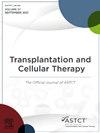Memory T-Cell Add Back and Prophylactic blinatumomab Post Tcrαβ Depleted Haploidentical Transplantation Results in Promising Outcomes in Pediatric Patients with High-Risk Acute Leukemia
IF 3.6
3区 医学
Q2 HEMATOLOGY
引用次数: 0
Abstract
TCRαβ depletion of haploidentical donor (haplo) grafts allows for low rates of GVHD but delays immune reconstitution (IR) in hematopoietic cell transplant (HCT) recipients. CD45RA-negative (memory) T cells have low alloreactivity, retain specificity for viral antigens, and can enhance IR without risk of GVHD. In this prospective clinical trial (NCT03849651), we addback memory T cells following TCRαβ/CD19 depleted haploHCT for children with hematological malignancies and administer prophylactic blinatumomab (blina) for patients with B-cell ALL to mitigate risk of relapse and avoid total body irradiation (TBI).
From 2019 to 2023, 69 patients received haplo HCT (ALL: 34, AML:33, MDS:1, NHL: 1) with a median age of 8.8 years (range: 0.5-21.6). Disease status at HCT was complete remission (CR)1 (n=28), CR2 (n=29), CR≥3 (n=11), and MDS (n=1). Donors included a parent (n=64) or sibling/other (n=5). All patients received a preparative regimen consisting of fludarabine, melphalan, cyclophosphamide, thiotepa, and anti-thymocyte globulin. No post-HCT GVHD prophylaxis was used. Patients received memory T cells in 2 cohorts: a dose escalation cohort (n=29 patients with T cell dose/kg: 1 × 105: n=9; 1 × 106: n=10; 1 × 107: n=10) and a dose expansion cohort (n=40 additional patients based on maximal effective dose of 1 × 107 T cells/kg).
All patients but one engrafted with a median time to neutrophil engraftment of 10 days (range: 9-12). At a median of day +29 post-HCT (range: 22-57), 67 patients received memory T cell addback. At 4 weeks post-memory T cell addback, an increase in the mean CD3, CD8, and CD45RO+ T-cell counts (p<0.0001, p=0.001, p=0.0001) was observed. Emerging memory T cells were functional as judged by Elispot assays. TCR repertoire was comparable to donor by month 6. The incidence of acute GVHD within 28 days of memory T cells addback at dose level 1, 2 and 3 was 0% (0/9), 30% (3/10), and 2% (1/48) respectively. For the entire cohort, cumulative incidence of any grade acute GVHD, grade III-IV acute GVHD and chronic GVHD at 1 year was 26.1%, 10.1% and 4.3% respectively.
At a median of 32 days after memory T cell addback, 26 patients with ALL received blina. Of 21 evaluable patients, 61.9% (13/21) responded with B-cell aplasia (BCA). Median CD3 count prior to blina was significantly higher in patients who developed BCA (440/μL) compared to those did not (135/μL) (p<0.05). Relapses after blina occurred in 3/13 patients with BCA (CD19-pos: 2, unknown: 1), and 5/8 without BCA (CD19-pos: 3, unknown: 2).
For the entire cohort, OS and EFS at 1-year were 87.7% and 73.9%. The cumulative incidence of relapse and non-relapse mortality at 1-year were 23.2% and 2.9%.
In conclusion, our strategy led to overall promising outcomes. Addback of up to 1 × 107 memory T cells/kg led to robust IR with low rates of severe GVHD and use of prophylactic blina was associated with comparable rates of relapse to TBI-containing regimens.
记忆t细胞补充和预防性blinatumumab后Tcrαβ缺失单倍体移植在高危急性白血病儿童患者中的前景
单倍体相同供体(haplo)移植物的TCRαβ耗损可以降低GVHD的发生率,但会延迟造血细胞移植(HCT)受者的免疫重建(IR)。cd45ra阴性(记忆)T细胞具有低的同种异体反应性,保留对病毒抗原的特异性,并且可以增强IR而不存在GVHD的风险。在这项前瞻性临床试验(NCT03849651)中,我们对患有血液病的儿童在TCRαβ/CD19缺失的单倍hct后添加记忆T细胞,并对b细胞ALL患者给予预防性blinatumomab (blina),以降低复发风险并避免全身照射(TBI)。从2019年到2023年,69例患者接受了haplo HCT (ALL: 34, AML:33, MDS:1, NHL: 1),中位年龄为8.8岁(范围:0.5-21.6)。HCT时疾病状态为完全缓解(CR)1 (n=28)、CR2 (n=29)、CR≥3 (n=11)和MDS (n=1)。捐赠者包括父母(n=64)或兄弟姐妹/其他(n=5)。所有患者均接受由氟达拉滨、美法兰、环磷酰胺、硫替帕和抗胸腺细胞球蛋白组成的预备方案。未使用hct后GVHD预防措施。患者接受记忆T细胞治疗分为两个队列:剂量递增队列(n=29例患者,T细胞剂量/kg: 1 × 105:n=9;106年1 × :n = 10;1 × 107:n=10)和剂量扩大队列(n=40名额外患者,基于1 × 107 T细胞/kg的最大有效剂量)。除1例患者外,所有患者移植中性粒细胞的中位时间为10天(范围:9-12)。在hct后的中位天+29(范围:22-57),67例患者接受了记忆T细胞补充。在记忆T细胞补充后4周,观察到平均CD3、CD8和CD45RO+ T细胞计数增加(p<0.0001, p=0.001, p=0.0001)。Elispot检测显示新兴记忆T细胞功能正常。到第6个月,TCR指标与供体相当。在剂量水平1、2和3的记忆T细胞补充后28天内急性GVHD的发生率分别为0%(0/9)、30%(3/10)和2%(1/48)。在整个队列中,1年内任何级别急性GVHD、III-IV级急性GVHD和慢性GVHD的累积发病率分别为26.1%、10.1%和4.3%。在记忆T细胞修复后的中位32天,26名ALL患者接受了盲治疗。在21名可评估的患者中,61.9%(13/21)的患者对b细胞发育不全(BCA)有反应。BCA患者致盲前CD3中位数(440/μL)明显高于未发生BCA的患者(135/μL) (p < 0.05)。3/13 BCA患者(CD19-pos: 2,未知:1)和5/8无BCA患者(CD19-pos: 3,未知:2)出现盲症后复发。在整个队列中,1年OS和EFS分别为87.7%和73.9%。1年累计复发率和非复发死亡率分别为23.2%和2.9%。总之,我们的战略带来了总体上有希望的结果。添加高达1 × 107个记忆T细胞/kg导致严重GVHD发生率低的强IR,使用预防性blina与含tbi方案的复发率相当。
本文章由计算机程序翻译,如有差异,请以英文原文为准。
求助全文
约1分钟内获得全文
求助全文
来源期刊

Transplantation and Cellular Therapy
Medicine-Hematology
CiteScore
7.00
自引率
15.60%
发文量
1061
审稿时长
51 days
 求助内容:
求助内容: 应助结果提醒方式:
应助结果提醒方式:


